
Prostanthera lasianthos, commonly known as the Victorian Christmas bush, is a large shrub or small tree of the mint family, Lamiaceae, which is native to Queensland, New South Wales, Victoria and Tasmania in Australia. It grows up to 10 m (35 ft) high but is usually much less and is found in wet sclerophyll forests, often beside creeks. Its flowers, which appear in profuse sprays, are about 2 cm long and white or pale lilac, with purple and orange blotches in the throat. They appear in late spring and summer, and specifically around Christmas time in Victoria. The fragrant, toothed leaves are 4 to 12 cm long and about 1.5 cm wide.

Melaleuca huegelii, commonly known as chenille honey-myrtle, is a plant in the myrtle family, Myrtaceae and is endemic to the south-west coastal areas of Western Australia. It has small, almost scale-like leaves and flower spikes sometimes more than 100 millimetres (4 in) long on the ends many of its branches.

Melaleuca cuticularis, commonly known as the saltwater paperbark is a tree in the myrtle family, Myrtaceae and is native to the south-west of Western Australia. There is also a disjunct population on Kangaroo Island in South Australia. It is distinguished from other melaleucas by its unusual fruits and very white, papery bark.

Melaleuca elliptica, commonly known as the granite bottlebrush is a plant in the myrtle family, Myrtaceae and is endemic to the south of Western Australia. The Noongar name for the plant is gnow. It is commonly grown in gardens because of its neat foliage and showy, bright red flower spikes although it needs to be pruned regularly to avoid becoming woody and untidy-looking. In nature, it usually grows in the shrub layer in mallee woodland or heath.

Calothamnus sanguineus, commonly known as silky-leaved blood flower, is a plant in the myrtle family, Myrtaceae and is endemic to the south-west of Western Australia. The Noongar peoples know the plant as Boolgalla. It is an erect to spreading shrub with short, cylindrical leaves and red or white flowers with an unusual arrangement of stamens, often flowering in autumn, winter or spring. It was the first of its genus to be formally described.
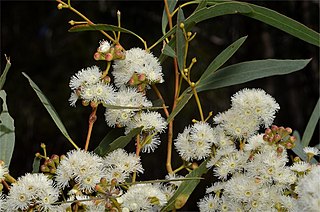
Eucalyptus amygdalina, commonly known as black peppermint, is a species of flowering plant that is endemic to Tasmania. It is a small to medium-sized tree with rough bark on park of the trunk, smooth grey to brown bark above, lance-shaped to linear adult leaves, oval to club-shaped flower buds, white flowers and cup-shaped to hemispherical fruit.
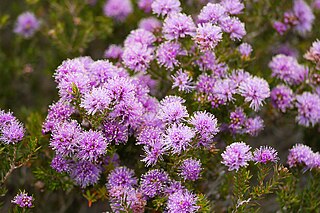
Melaleuca squamea, commonly known as swamp honey-myrtle, is a plant in the myrtle family, Myrtaceae and is endemic to south eastern parts of Australia, especially Tasmania. It is an erect shrub growing in damp and swampy places with crowded leaves and many heads of pink to purple flowers in spring.
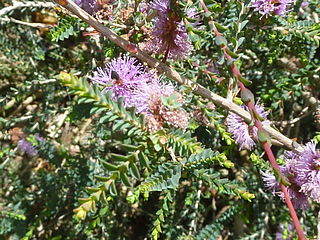
Melaleuca gibbosa, commonly known as the slender honey-myrtle or small-leaved honey-myrtle is a plant in the myrtle family, Myrtaceae and is endemic to southern Australia. It is a dense, bushy shrub to about 2 metres (6.6 ft) with numerous slender, arching branches and oblong heads of mauve flower spikes in spring and sparsely throughout the year.

Melaleuca filifolia, commonly called wiry honey-myrtle, is a plant in the myrtle family Myrtaceae, and is endemic to the south-west of Western Australia. It is a woody, twiggy shrub with needle-shaped leaves, greenish flower buds, pink "pom-pom" flower heads and spherical clusters of fruits.

Melaleuca glaberrima is a plant in the myrtle family, Myrtaceae and is endemic to the south-west of Western Australia. It is a dense, spreading shrub with needle shaped, but not sharp leaves and profuse pink or mauve flowers.

Melaleuca pentagona is a plant in the myrtle family Myrtaceae and is endemic to the south of Western Australia. It is a showy, medium-sized shrub which produces large numbers of pink flowers in spring. There are three varieties recognised, one of which has been known in cultivation for many years.

Melaleuca suberosa, commonly known as corky-bark honey-myrtle or corky honeymyrtle, is a shrub in the myrtle family, Myrtaceae, and is endemic to the south of Western Australia. It is a distinctive shrub, recognised by its tiny, crowded leaves, corky bark and pink flowers that appear along lengths of leafless parts of the branches.
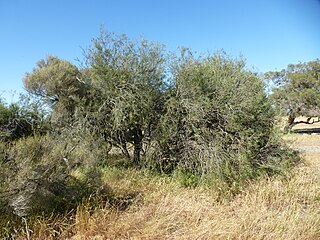
Melaleuca teretifolia is a plant in the myrtle family, Myrtaceae, which is endemic to the south-west of Western Australia. It is a shrub with long, thin leaves and clusters of usually white flowers along considerable lengths of the branches in late spring and summer.

Melaleuca thymoides is a plant in the myrtle family, Myrtaceae, and is endemic to the south-west of Western Australia. It is usually a low shrub. The ends of the branches usually end in a sharp spine and the leaves also have a sharp point. Bright yellow flowers appear on the ends of the branches in spring or early summer.
Persoonia striata is a species of flowering plant in the family Proteaceae and is endemic to the south-west of Western Australia. It is an erect, often spreading shrub with hairy young branchlets, linear to spatula-shaped leaves, and bright yellow flowers borne in groups of up to five on a rachis up to 2 mm (0.079 in) long that continues to grow after flowering.
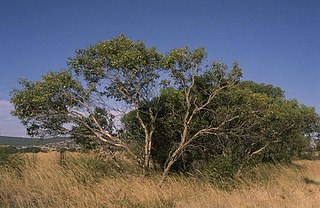
Eucalyptus incrassata, commonly known as the lerp mallee, yellow mallee, ridge fruited mallee or rib fruited mallee, is a species of mallee that is endemic to southern Australia. It has smooth bark, sometimes with rough, ribbony bark near the base, lance-shaped adult leaves, flower buds in groups of seven, creamy white, pale yellow, sometimes pink or red flowers, and cylindrical, barrel-shaped or bell-shaped fruit.

Leptospermum sericeum, commonly known as the silver tea tree, is a species of shrub that is endemic to the south-west of Western Australia. It has thin, firm bark, egg-shaped leaves with the narrower end towards the base, relatively large, pink flowers and fruit that fall from the plant with the seeds. It grows in windswept rock crevices near Esperance.

Leptospermum glaucescens, commonly known as the blue-green tea tree or smoky tea tree, is a species of shrub or small tree that is endemic to Tasmania. It has elliptical to egg-shaped leaves that are often greyish green, white flowers about 15 mm (0.59 in) in diameter arranged in consecutive leaf axils and fruit that remain on the plant for some time after maturity.
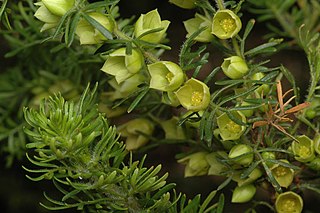
Boronia tetrandra, commonly known as yellow boronia, is a plant in the citrus family, Rutaceae and is endemic to Western Australia. It is a spreading or erect shrub with hairy stems, pinnate leaves and greenish cream to yellow or reddish brown, cup-shaped, four-petalled flowers.

Hibbertia acicularis, commonly known as prickly guinea-flower, is a species of flowering plant in the family Dilleniaceae and is endemic to eastern Australia. It is an erect or prostrate shrub with linear to lance-shaped leaves and yellow flowers arranged singly in leaf axils with the six to eight stamens joined at the base, in a single cluster.




















